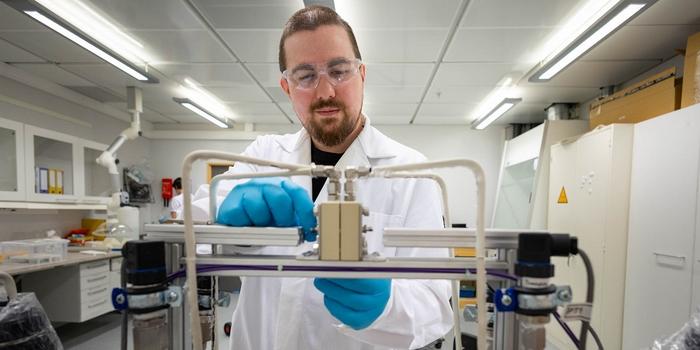Norway wastes huge amounts of energy. Surplus heat produced by industry is hardly exploited at all.

Credit: Photo: Aleksander Stokke Båtnes, NTNU
Norway wastes huge amounts of energy. Surplus heat produced by industry is hardly exploited at all.
Researchers at the Norwegian University of Science and Technology (NTNU) have been looking at the possibilities for doing something about this.
“Surplus heat from industrial processes is a huge resource,” says Kim Kristiansen.
He has just completed his PhD on a technology that can harness some of the surplus heat that currently goes to waste. Almost all the heat generated by industrial processes is currently released directly into the air or the ocean, and we are not talking about small amounts. In Norway alone, industry produces around 20 TWh of waste heat each year.
That number might not mean much to you, but according to the Norwegian Water Resources and Energy Directorate (NVE), this amount of energy corresponds to half of the electricity consumption of all Norwegian households combined. In other words, approximately the entire heating demand.
Kristiansen is part of the thermodynamics research group at PoreLab in the Department of Chemistry. Academic supervisor Signe Kjelstrup and research group manager Øivind Wilhelmsen are co-authors of the articles in question.
Drinking water as an added bonus
The technology also has another effect that may not be as relevant in Norway, but which might be a game changer in countries with limited drinking water.
“The technology doesn’t just recycle the waste heat energy, it can also purify the waste water produced by industry,” says Kristiansen.
In many parts of the world, drinking water is becoming an increasingly scarce resource.
“According to UNICEF, four billion people are already experiencing severe drinking water shortages for at least one month of the year, and there is a high demand for technology that can meet these challenges,” says Kristiansen.
A lack of drinking water is therefore a problem for approximately half of the world’s eight billion people.
Producing clean water
So what is this new technology?
“The waste water produced by industry is often contaminated. If we evaporate this impure water through small pores in a water-repellent membrane, the condensed water that emerges on the other side is drinkable,” says Kristiansen.
This method is best suited for purifying water with so-called non-volatile impurities, such as salt. This is in contrast to alcohols and a number of other organic substances that can evaporate along with the water through the membrane.
“The most important area of application for this technology is therefore desalination of seawater. The treatment of process water is not being ruled out, but it involves additional challenges depending on its content,” says Kristiansen.
So, the technology can produce drinking water, but what about exploiting the waste energy?
Exploiting temperature differences to pump up water
When water is heated on one side of the membrane, it evaporates and releases heat on the other side through condensation. A pressure difference may then arise between the two sides of the membrane
“The temperature difference is used to pump the water up, and the pressure difference represents mechanical energy that can be used to power a turbine,” says Kristiansen. The phenomenon is called thermal osmosis.
Seemingly simple, but ingenious.
“We have investigated the interactions between water and the pores in the membrane, and what happens when the water evaporates, is transported through the pores, and condenses,” says Kristiansen about the doctoral research.
He has designed theories on membrane properties and the effect they have on the entire process. He has also systematically measured this effect in the laboratory.
“The conclusion is that the technology has great potential. Through modification of the membranes, we can help address both the increasing challenges associated with energy efficiency requirements and the lack of clean drinking water,” says Kristiansen.
A Dutch idea
Kristin Syverud at the RISE PFI research institute is interested in improving the membranes used in this technology.
“The starting point for the work was an idea that TNO in the Netherlands gets the credit for,” says Kristiansen’s academic supervisor Signe Kjelstrup.
She is Professor Emerita and former Head Researcher at PoreLab – Centre of Excellence. TNO is an independent institute that works to translate research findings into real-life applications.
TNO experimented with the concept called ‘MemPower’ (simultaneous production of water and power) and the prototype was made at their facilities. The researchers wanted to collaborate but had no funding. The solution was to continue the project as open research at NTNU.
“Leen van der Ham from TU Delft got in touch with me and I introduced the idea to the group I then had at the Department of Chemistry, and later at PoreLab.”
Van der Ham took his PhD in Chemistry at NTNU a few years ago, which shows just how important it is to have contacts. They worked with Luuk Keulen, a student at TU Delft, and the research was continued by Kristiansen and Michael Rauter from PoreLab.
Practical challenges
“Industry is showing interest in the concept of membrane distillation, but so far, there are only a few pilot plants worldwide,” says Kristiansen.
The main reason industry is lagging behind academia is related to practical challenges associated with membrane technology, he explains. For example, this applies to the lifespan of membranes under harsh industrial conditions.
“A lot of work is being done internationally in both academia and industry to meet these challenges and commercialise the technology,” says Kristiansen.
The MemPower concept involves converting waste heat into mechanical energy based on differences in temperature.
“My impression is that industry is not yet fully aware of this concept and the opportunity it offers,” says Kristiansen.
One of the conclusions in the latest article is that the potential for energy production is competitive in relation to more established membrane-based energy processes. He believes this could help increase commercial interest.
Reference: Kristiansen, Kim and Wilhelmsen, Oivind and Kjelstrup, Signe, Thermo-Osmotic Coefficients in Membrane Distillation experiments and Theory for Three Types of Membranes. Desalination, Volume 586, 2024, 117785, ISSN 0011-9164, https://doi.org/10.1016/j.desal.2024.117785
Journal
Desalination
DOI
10.1016/j.desal.2024.117785
Method of Research
Experimental study
Subject of Research
Not applicable
Article Title
Thermo-osmotic coefficients in membrane distillation: Experiments and theory for three types of membranes
Article Publication Date
7-Jun-2024




